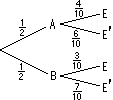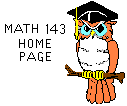

|
|
The above information is from your computer : be sure it is correct. For grade credit, submit over the internet by 11:59 PM (= 23:59 hours) on Sunday 1 May 2016 |
Math 76O-143 Finite Mathematics
Self-marking Homework Assignment #6
SETS AND PROBABILITY
Submit over the internet by 11:59 PM on Sunday 1 May 2016
Maximum value toward semester grade is 4 pts
Methods will be discussed in class;
CAUTION: Prof McFarland makes new tests each semester.
| Average grade on Fall 2015 paper test # 6 : 27.66 | Perfect = 45 | See future grade prospects? |
| [2] |
|
|
|||
|
(a)(3 pts) Place numbers in the appropriate parts of the Venn diagram at the right so as to interpret the given information. Scoring: 1 point for center number only 2 points for center number and 3 adjacent numbers only. |
|||||
| (b)(1 pt) How many students read at least one magazine? | |||||
| (c)(1 pt) How many students read exactly two magazines? | |||||
 |
|
| [3] |
|
|
| (b)(2 pts) Four balls are chosen from an urn containing 8 white balls and 7 blue balls. In how many ways can exactly 3 of the 4 balls be blue? | ||
| (c)(2 pts) How many different 5-card poker hands are there? | ||
| [4] | (a)(2 pts)(a) In how many ways can a TV manager schedule all 6 different commercials into 6 available time slots reserved for commercials? | |
|
||
| (c)(1 pt) One card is drawn from a standard 52-card deck ; what is the probability that the card is a diamond? |
| [5] |
(a)(2 pts) A pair of dice is cast ;
what is the probability that one die shows "6" and the other shows less than 3? |
|
(b)(1 pt) A pair of fair dice is cast ;
what is the probability that the faces show the same number? |
|
(c)(2 pts) Let E and F be two mutually exclusive
events, for which P(E) = 0.2 and P(F) = 0.5 ; find P(E  F). F).
|
| [6] |
|
|
(b)(1 pt) In a lottery, a 4-digit number is
picked (such as 0226); what is the probability that a
lottery player gets at least the first digit correct? |
|
(c)(2 pts) A druggist must randomly choose 4 brands
from amongst six brands A,B,C,D,E, and F to stock in her store. What is the
probability that one of the brands will be B? |
| [7] |
(a)(2 pts) Using data from the tree
diagram at the right, find P(E). |
 |
||
(b)(2 pts) Again using data from the tree
diagram at the right, find P(A E). E). |
||||
|
| [8] |
|
|||||||||||||||||||
|
||||||||||||||||||||
|
||||||||||||||||||||
|
||||||||||||||||||||
|
(b)(1 pt) Check the alternative below which correctly interprets the number
" ¾ " in problem [8] above. A correct answer (and 1 point) here requires a correct answer to [8a] above, |
||||||||||||||||||||
|
||||||||||||||||||||
|
(c)(1 pt) Check the alternative below which correctly interprets the number "½" in
problem [8] above. A correct answer (and 1 point) here requires a correct answer to [8a] above, |
||||||||||||||||||||
|
||||||||||||||||||||
|
(d)(1 pt) Find P(A | D), that is, find the probability that the chosen coin was the penny. |
||||||||||||||||||||
| [9] |
(a)(2 pts) A fair coin is tossed 6 times: the probability of a head
on each toss is therefore ½. What is the probability that exactly 3 of
these tosses result in heads? |
|
(b)(3 pts) A fair coin is tossed 6 times: the
probability of a head on each toss is therefore ½. What is the probability
that at least 3 of these tosses result in heads? |
Comments or complaints regarding this page
|
|
|
|
When you have done your best above, submit your homework to Professor HERE. Be sure your email address is correct above: your graded homework will be immediately copied there! |
|
 |
 |